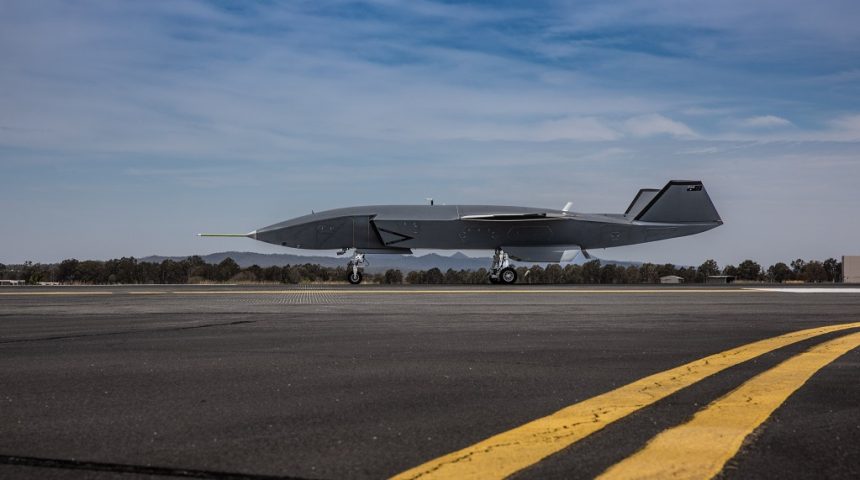The Artificial Intelligence-powered Loyal Wingman Unmanned Aerial Vehicle for the Royal Australian Air Force will be also independent from runways.
Boeing Australia recently announced that the Loyal Wingman unmanned aircraft developed for the Royal Australian Air Force hit another milestone with the first low-speed taxi test under its own power, getting one step closer to the first flight that is planned later this year.
According to the press release, the aircraft reached during the test a maximum speed of 14 knots, demonstrating various systems while maneuvering on the ground. “The low-speed taxi enabled us to verify the function and integration of the aircraft systems, including steering, braking and engine controls, with the aircraft in motion,” said Paul Ryder, Boeing Australia Flight Test manager.
Watch as the unmanned #LoyalWingman moves along the runway for the first time under its own engine power. Next up: high-speed taxi testing, followed by first flight! #AirpowerTeaming pic.twitter.com/Y7JyOGEFMX
— Boeing Australia (@BoeingAustralia) October 22, 2020
As in other occasions, Boeing did not disclose the location of the testing of the first Loyal Wingman however, as we reported in August, local photographers spotted the aircraft while it was being towed at RAAF Base Amberley, some 40 km south-west of Brisbane, home of Boeing Australia. This could be further confirmed by satellite photos of the base showing the same time of pads with blast deflectors that were visible in the photos from the first engine test run.
The press release shared this time a pretty interesting fact that was not mentioned before. The Airpower Teaming System will be independent from runways, adding also that it will be able to self-deploy and land almost everywhere in a tweet accompanied by a quick video of the aircraft preparing to land on an improvised runway. “Runway independence ensures the aircraft will be a highly flexible and adaptable system for our global customers,” said Dr. Shane Arnott, program director, Boeing Airpower Teaming System. “This latest test marks the first full unmanned movement of the Loyal Wingman with our Australian partners and takes us a step closer to first flight.”
#LoyalWingman is taxi testing on a runway for now, but in the future this unmanned aircraft will be able to self-deploy and land almost anywhere! #AirpowerTeaming pic.twitter.com/VBRyQSKH84
— Boeing Defense (@BoeingDefense) October 22, 2020
Here are the details about the Loyal Wingman program disclosed by Boeing until now and that we already reported:
As we wrote in occasion of the roll-out, this drone is the first clean-sheet design created by Boeing outside the United States and also the first RAAF’s clean-sheet design in more than 50 years. The project, which involved several Australian companies, used new development techniques, like the “digital twin” concept, and new automated production systems.
One of the key features of the ATS is an 8.5 ft (2.6 m) long modular nose cone with 9000 cubic inches internal volume to house different payloads, which can be entirely swapped quickly according to the mission’s needs.
A similar AI-based program, called Skyborg Vanguard Program, is also in development by the U.S. Air Force and the Air Force Research Laboratory (AFRL). Skyborg is described as “an autonomy-focused capability that will enable the Air Force to operate and sustain low-cost, teamed aircraft that can thwart adversaries with quick, decisive actions in contested environments.”
The system’s functioning looks similar to the Boeing ATS: “Military pilots receive key information about their surroundings when teamed aircraft with integrated autonomy detect potential air and ground threats, determine threat proximity, analyze imminent danger, and identify suitable options for striking or evading enemy aircraft. Embedded within the teamed aircraft, complex algorithms and cutting-edge sensors enable the autonomy to make decisions based on established rules of engagement set by manned teammates. Field tests will ensure the algorithms’ accuracy and verify that the system continuously operates within the constraints established during mission planning.”
For a quick comparison, the ATS will be flown by Artificial Intelligence (AI) and controlled from the back seat of a Super Hornet or a Growler for smaller formations, or from a control station aboard a Wedgetail or a Poseidon. Boeing didn’t provide details on how the AI specifically works, but explained that the controller will simply signal the mission intent to the Loyal Wingman and the AI will figure out by itself mission specifics and navigation, while keeping a safe separation from other manned and unmanned aircraft.
Boeing plans to submit a variant of ATS for Skyborg. Other companies competing in the program are Northrop Grumman, General Atomics and Kratos.









